
Rhodymenia californica
California Rose Seaweed
23 July 2024
Big Beach, Vancouver Island, B.C., Canada
Tide: 0.2 feet at 08:45 PDT (measured at Ucluelet Tidal Station)
Weather: Mostly cloudy (90% cloud cover), wind West 0 – 5 km/hour, sea smooth, low westerly swell, humidity 94%, 14 ˚C.
Moon: Waning Gibbous (93.5%, 18 days); Next Phase, Third Quarter, 27 July 2024 at 7:51 pm PDT; Previous Phase, Full Moon, 21 July 2024 at 3:17 am PDT.
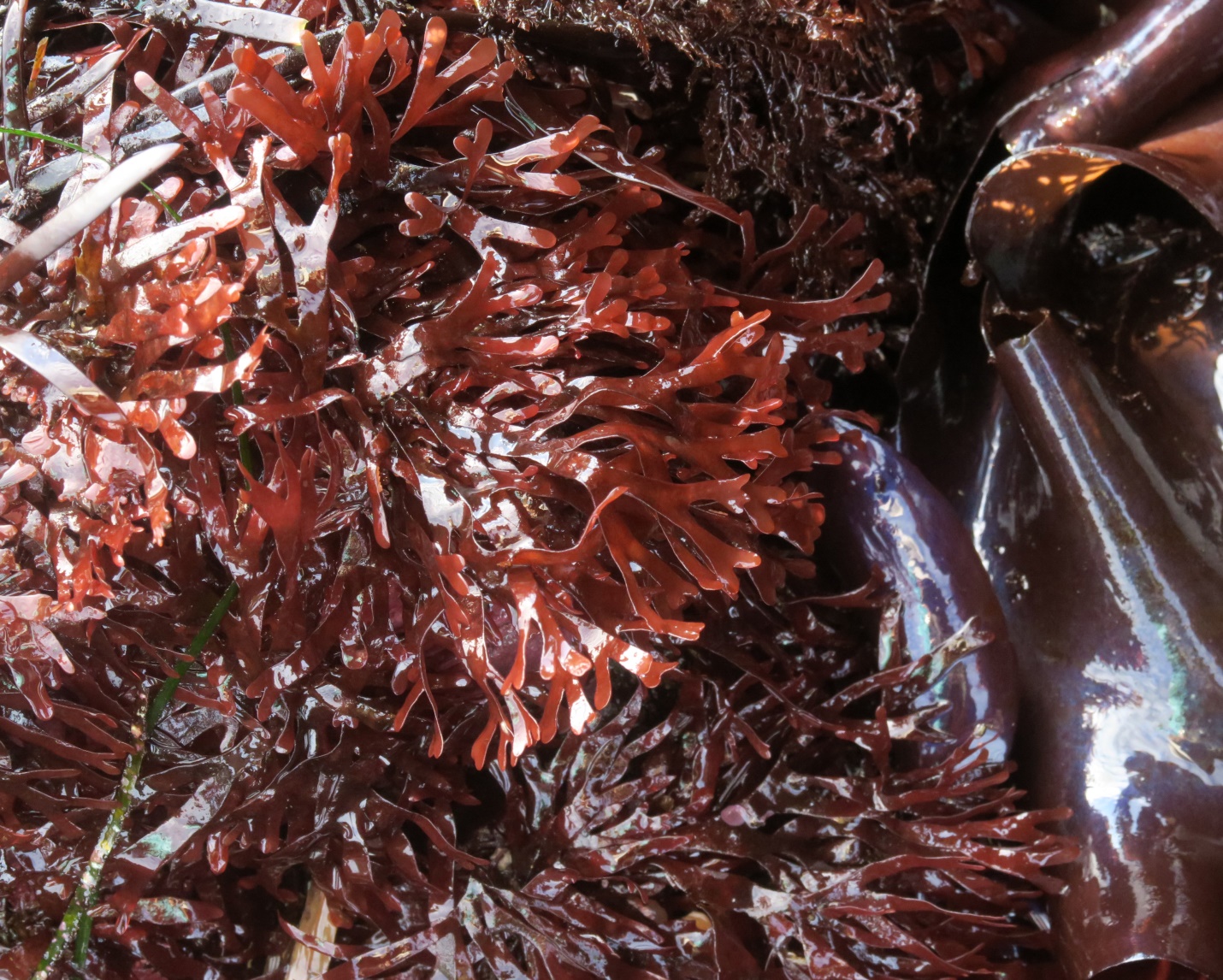
Figure 1: Layered, Y-branching, fans of red algae, this is Rhodymenia californica looking really very grand. Light reflects off the smooth surfaces and also goes through as the cartilaginous blades are translucent. Big Beach, Vancouver Island, B.C., Canada. July 23, 2024. Photo ID 27731 ©Seaweedwhisperings.com
Person 1:
Crowded.
In a dense group, but individuals are easily discernable.
Each have distinct forked “antennae”..., don’t want to miss any conversations going on around them.
Gossipy.
Shiny, smooth appearance.
Individual fronds feel smooth, but upon running my fingers over the whole thallus they seem coarser.
Thalli fan out..., another way to enhance “listening”.
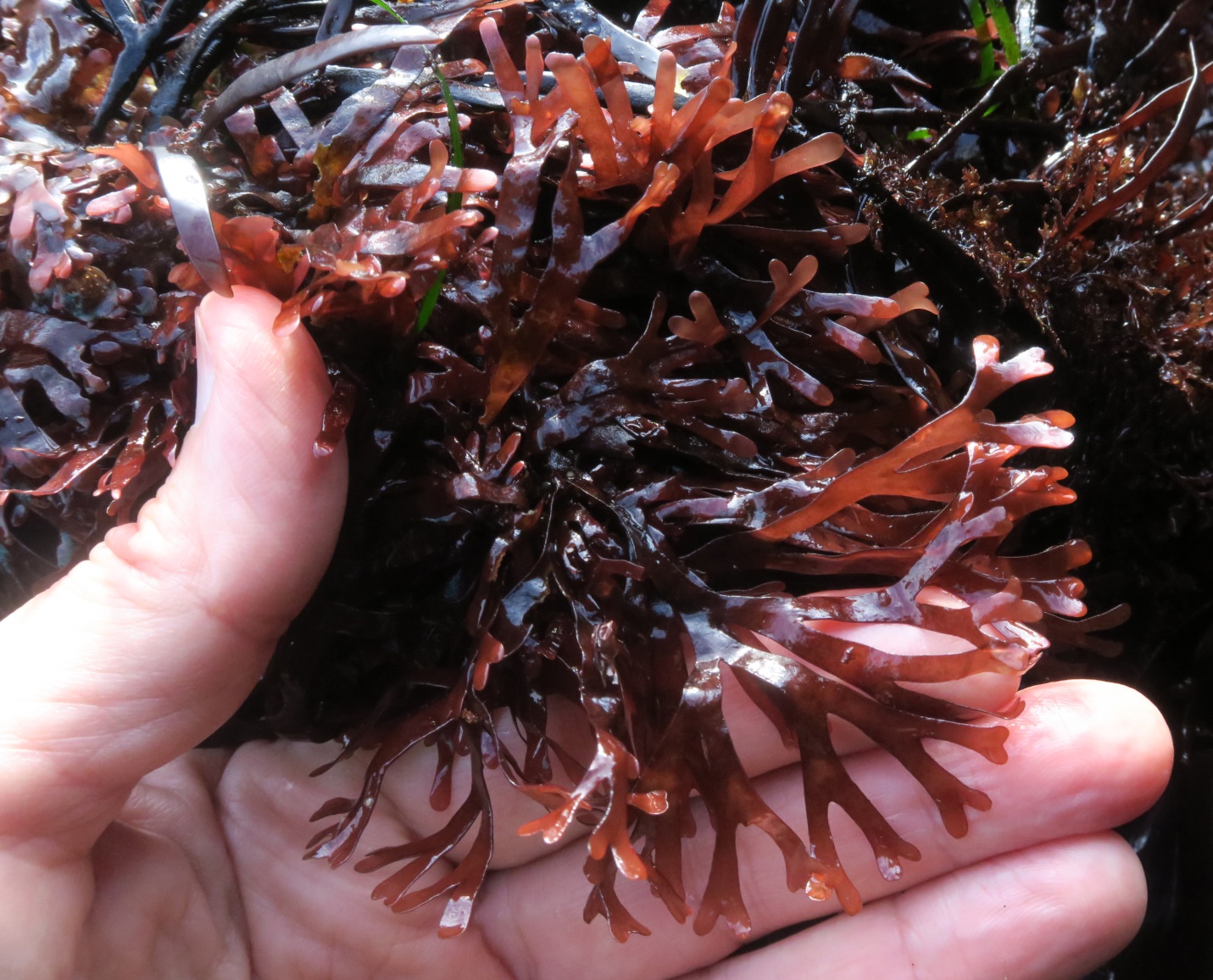
Figure 2: The dichotomous branching of California Rose Seaweed is seen here. This seaweed grows mainly flattened on one plane but that plane also has a bit of waviness to it which adds interest and angles for light gathering and reflecting properties. Big Beach, Vancouver Island, B.C., Canada. July 23, 2024. Photo ID 27732 ©Seaweedwhisperings.com
Person 2:
At the low tide here the shoreline is profusely covered in seaweed. Lowest are many species of ‘reds’, all richly glowing red in the early morning light. And down very close to the waterline, shaded by a large boulder, there are some smaller reds. They must enjoy the shadier areas – one cluster is even growing right next to the extreme-shade-loving green alga, Codium setchellii.
Deep rose-red, translucent, cartilaginous, dichotomously branching with branches all staying uniformly narrow, flattened mainly on one plane.
This red has a ‘slender’ aspect to it. There is no chubbiness anywhere. I thought, maybe they’re on a diet! This reminds me of the various dieting fads that seemed to originate in the American state of California (and this species is named for California!)..., diets all designed to help one look very slim and fit.
There is light here, enough for you, yes, but not enough for extras. This is a kind of diet, a rationing of light or a skill at working with not very much light.
Surface is smooth, shiny, reflects the light. Maybe you can maximize it this way, share it with others.
In rare moments of sunlight that reach your shady habitat, light goes through you. In the shade, light reflects, bounces around, travels a bit more in your little neighborhood.
A patch of you has dared to grow further away from the protective shade of this boulder and slightly higher in the intertidal. At this morning’s low tide and sunny warm weather, you seem a bit duller – a wee bit unhappy to be exposed and drying out.
The nearby large blades of Mazzaella splendens missed coming to rest over top you when the tide last receded by only a small distance. Being covered would have suited you more.
In fact I felt compelled to help you out, and pulled the nearby M. splendens blades overtop you. I felt your gratitude when I did this!
In one area you are growing on medium sized cobble near the large boulder. You grow in terraces – lovely red fans descending from one cobble down to the next, descending also from lighter to shadier exposure. Somehow this terracing or layering gives me the idea again of assisting or helping others of your group. The idea is, “I’ll shade you now while I can do it, and I know you will shade me if you have the opportunity another time.”
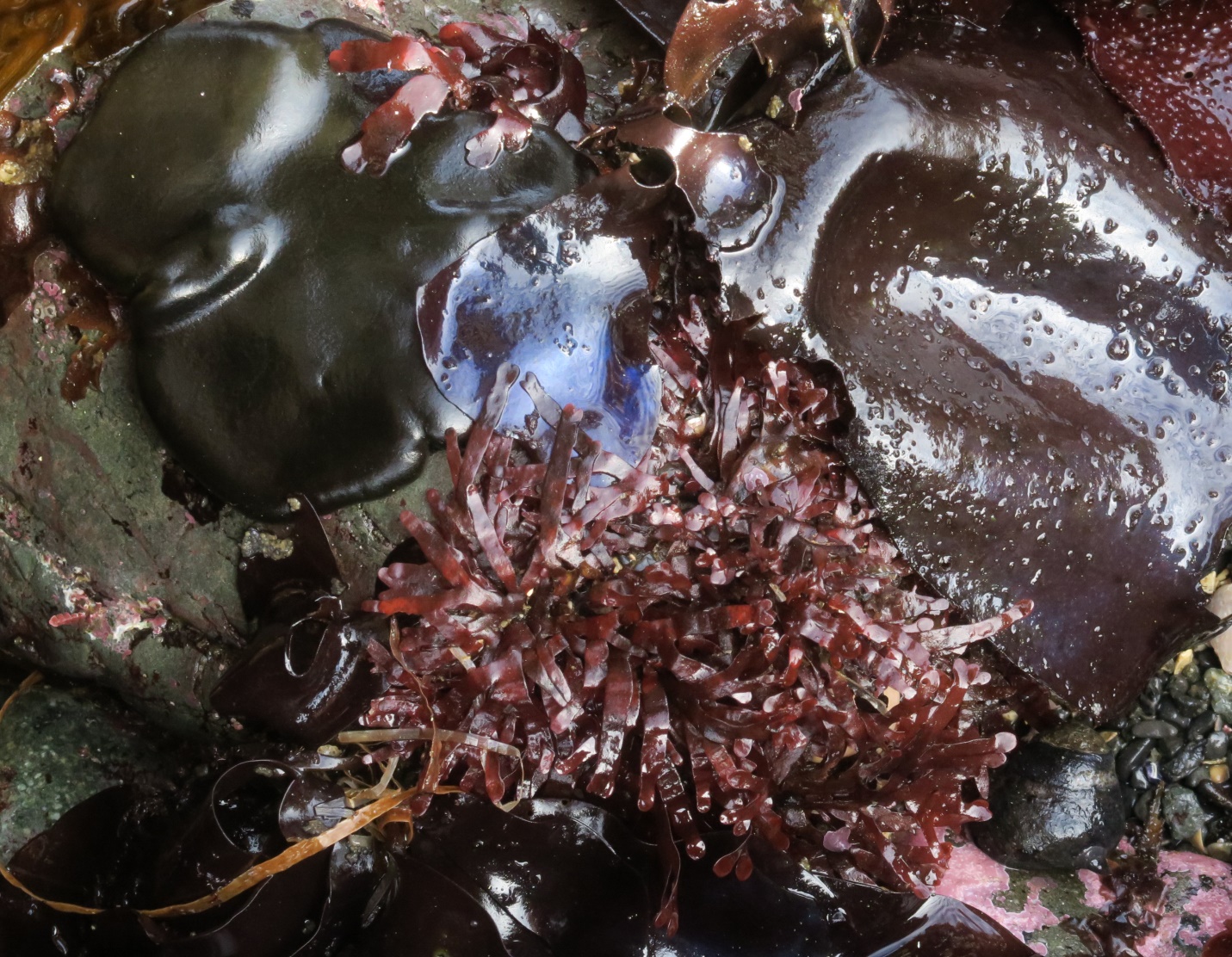
Figure 3: Pictured here growing on rock are Codium setchellii, the very deep green (almost black colored) spongy crust in the upper left quadrant of the frame, and also Rhodymenia californica, the narrow bladed and multi branched red alga in the foreground. The iridescent blue-violet blade of Mazzaella splendens and the fragments of bumpy Chondracanthus blades were not growing here but had been deposited in this shady crevice by the previous tide. Big Beach, Vancouver Island, B.C., Canada. July 23, 2024. Photo ID 27733 ©Seaweedwhisperings.com
Discussion:
The common name of this seaweed, California Rose, has the connotation of being noticeably beautiful. Person 1 felt it to be a very sweet name - a lovely, light, flowing name. There is a lovely look to this seaweed also, and while it is physically translucent the desire to gossip indicates much can be hidden or possibly misrepresented (as gossip often becomes easily twisted away from much that is factual) by their rosy good looks.
Even the whole community / grouping is really rather hidden and hard to find, let alone get to know and understand.
Person 2 wanted to provide ‘cover’ to the one exposed group, and indeed we felt this seaweed truly appreciates living their life under cover, and to be exposed to as little scrutiny as possible. Perhaps they’d even be happy to live incognito – concealing their true identity. Just why they prefer this is a bit of a puzzle. It could reflect a lack of self-confidence and certainly they are most comfortable in groups such as an extended family grouping or a neighborhood of known characters. Perhaps they feel too much is easily seen of them from the exterior (their translucency) and so they don’t willingly add anything more to that.
Related to living in the shade, yes, they do seem to love it and also they are well adapted to it. This adaptation limits them, too. They could not survive in areas exposed to more intense light. Possibly then, light can equal scrutiny, and they just don’t survive much of it.
Low light in a sense forces ‘dieting’. This is a key facet of their existence and their adaptation to occupy low light intertidal and subtidal niches. Their “slender” and “lean” look is therefore beautifully adapted to a life in close quarters where becoming too “light-hungry” is unsupportable and detrimental to the community.
Their translucency allows available light to be shared as well as their shining reflective surface – both traits achieve the same goal.
When in good health the lean diet is not a problem because you will be adequately taken care of by your community. Reflecting light is a way of sharing with others. With the light bouncing around it really is helping out – everyone is helping out everyone else in the neighborhood.
Enough – it feels like this red alga really lives an excellent life working with the concept of ‘enough’ – the comfortable place between need and greed.
We saw this seaweed growing right next to some Codium setchelli, a green alga that is supremely adapted to life in areas of very low light. C. setchelli’s adaptation to this low light condition is to soak up every ray of light that it can and hold it within for its own purposes. By contrast, we felt that the success of Rhodymenia californica is to live in communities and to share the light.
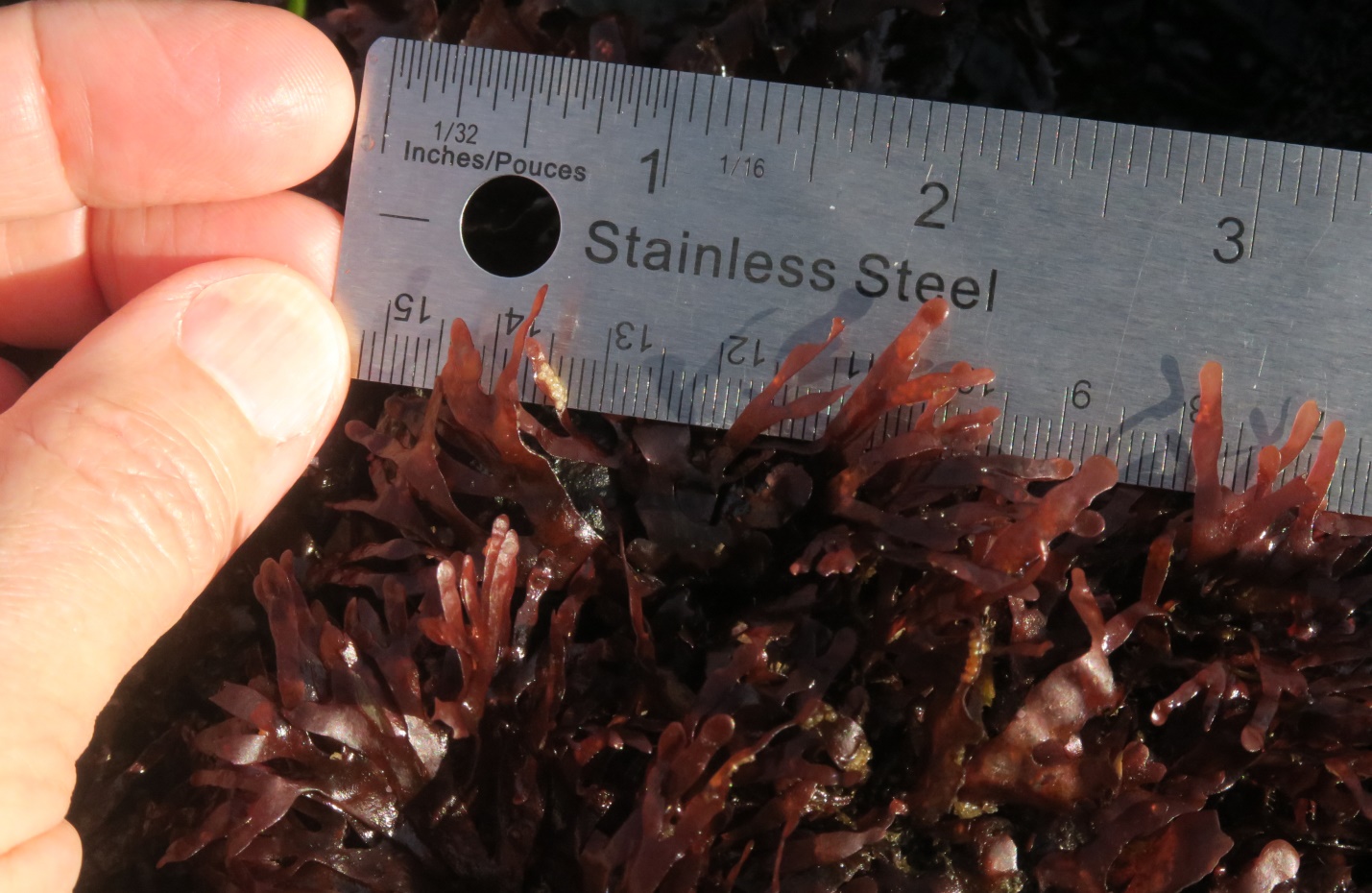
Figure 4: A ruler shows the narrow width of the blades – only about 2 mm. Big Beach, Vancouver Island, B.C., Canada. July 23, 2024. Photo ID 27734 ©Seaweedwhisperings.com
Biology & Natural History Information:
Description:
A translucent, rose red to deep red colored alga that grows in regularly dichotomous branches to 10 cm in height. It often is found growing in clusters or dense patches. The blades are smooth and cartilaginous and flattened mainly on one plane and the forked branching habit produces fan shaped (flabellate) thalli. Tips of the blades are rounded and the width of blades is between 1.5 to 3 mm. Rhodymenia californica and its near relative, Rhodymenia pacifica both can grow new blades vegetatively (asexually) from their holdfast of prominent horizontal stolons.
Habitat:
Abundant on rocks, and often mingled with Rhodymenia pacifica, but R. pacifica is larger and will grow deeper in the subtidal; low intertidal to shallow subtidal.
Distribution:
Northern British Columbia to Mexico; Galapagos Islands, Ecuador; Chile; Philippines.
Remarks:
Older thalli often become heavily encrusted with bryozoans, tubeworms, and hydroids; in this manner the seaweed provides territory for marine animals to live on. This species is one of many red algae that form part of the understory beneath larger and more obvious species such as the kelps. Just like their counterparts in the rain forest, they are adapted to grow with a reduced amount of light.
The type locality of this species is Pacific Grove, California, USA (Kylin 1931).
Classification:
Phylum: Rhodophyta
Class: Florideophyceae
Subclass: Rhodymeniophycidae
Order: Rhodymeniales
Family: Rhodymeniaceae
Genus: Rhodymenia
Species: Rhodymenia californica Kylin 1931
Other name(s):
Heterotypic synonyms: Rhodymenia attenuata E.Y.Dawson 1941; Rhodymenia californica var. attenuata (E.Y.Dawson) E.Y.Dawson 1963.
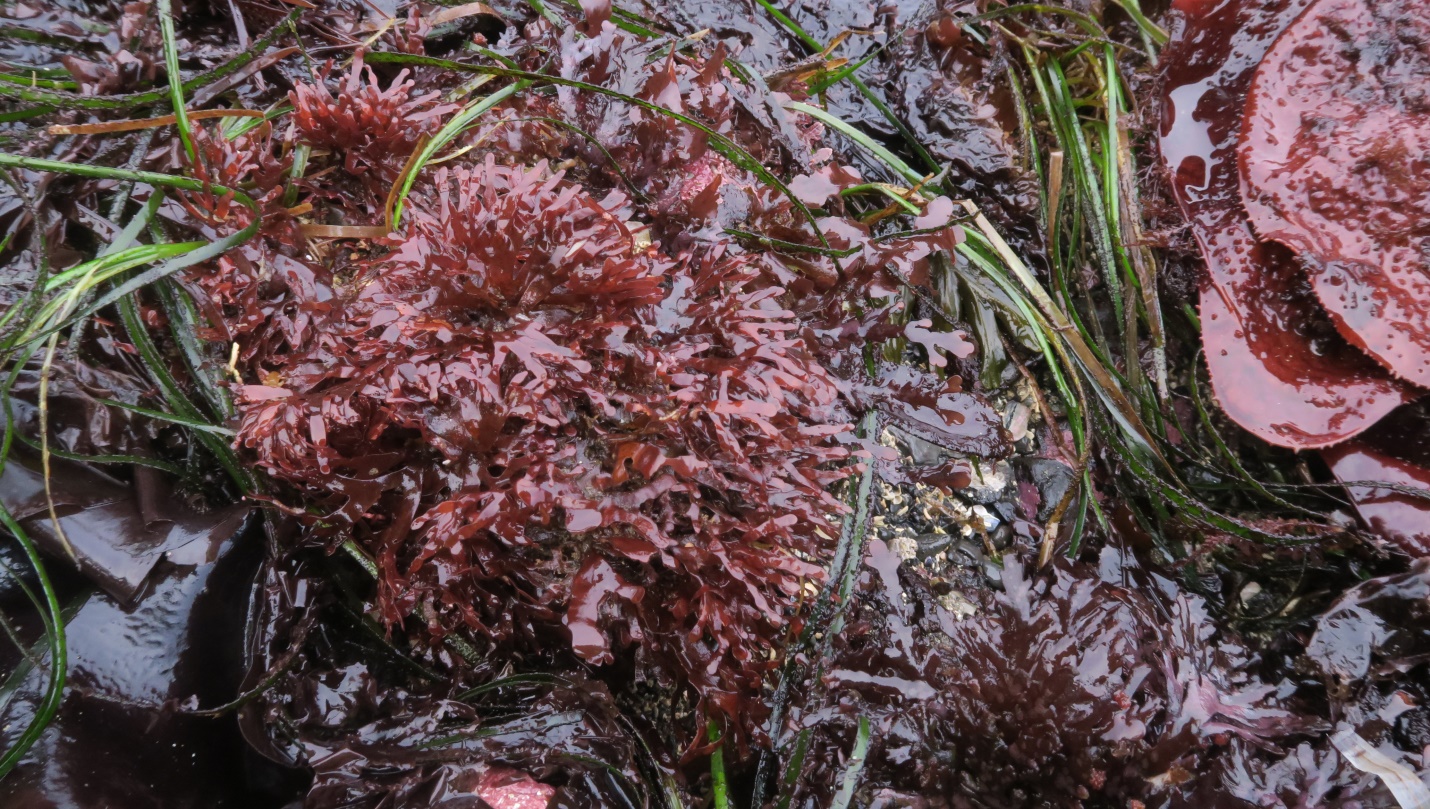
Figure 5: On a very low tide morning this cluster of Rhodymenia californica was left exposed to the desicating sun and air; as luck would have it, the larger bladed Mazzaella splendens had rested its blades in a different direction and so didn’t cover and shelter this low-light adapted red seaweed on this day. Big Beach, Vancouver Island, B.C., Canada. July 22, 2024. Photo ID 27735 ©Seaweedwhisperings.com
![]()